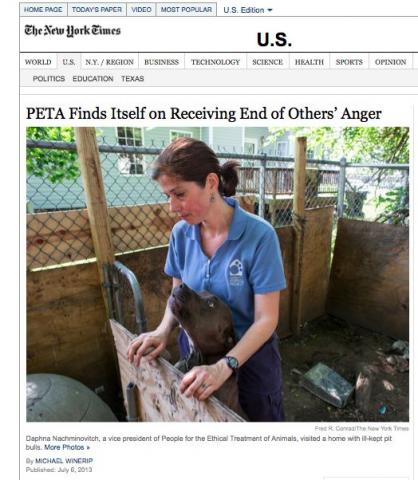NY TIMES BLASTS PETA’S KILLING RECORD
The killing of thousands of “rescued” dogs and cats by PeTA (People for the Ethical Treatment of Animals) has been a source of outrage to responsible animal welfare groups for years. Now, thanks to an article in the July 6 edition of the New York Times, even PeTA supporters are shocked at the news that their favorite “humane” group kills as many as 2,000 dogs and cats each year. Between 2006 and 2011, PeTA killed over 90 percent of the animals in its Norfolk, VA “shelter.”
“This is an organization that on Thanksgiving urges Americans not to eat turkey,” writes reporter Michael Winerip.
His article describes the growth of the no-kill movement at shelters across the nation, noting that as the no-kill movement has gained momentum, PeTA has been “left behind.” Winerip reports that one no-kill activist recently criticized PeTA on his blog for “its long and sordid tradition of undermining the movement to end shelter killing.”
Responsible animal welfare organizations have moved quickly to distance themselves from PeTA’s disgrace, according to the story. Maddie’s Fund, a San Francisco-based foundation supporting no-kill shelters, provides funding for shelter veterinary programs and adoption initiatives to reduce the number of pets languishing in shelters. Foundation Director Richard Avanzino reportedly called PeTA’s killing policy “outdated” and “absolute idiocy.”
In the article, Winerip describes his own visit to PeTA headquarters, where he was “led…to a cinder block building in the back and then to a windowless room where the dogs and cats are killed.” He described the room as clean and well-maintained. His PeTA tour guide told him, “It’s a humane exit from a world that’s treated them like garbage. It’s very sad, but in these cases, it’s the best we can hope for.”
“A world that’s treated them like garbage.” PeTA should know. In 2005, two PeTA employees were charged with cruelty to animals when they were caught dumping garbage bags containing euthanized pets into a trash dumpster. That incident led to the first public exposure of PeTA’s merciless killing policy.

